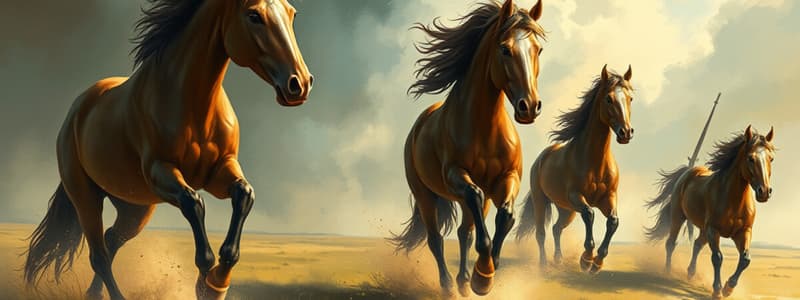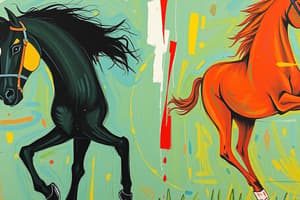Podcast
Questions and Answers
What does the use of auditory imagery, such as ‘hissing’ and ‘snuffling’, add to the poem?
What does the use of auditory imagery, such as ‘hissing’ and ‘snuffling’, add to the poem?
- It distracts the reader from the main themes of the poem.
- It evokes a sense of calm and tranquility.
- It creates a tense atmosphere and enhances the visual imagery. (correct)
- It simplifies the emotional impact of the poem.
What is the significance of comparing a torn leaf to a maimed limb?
What is the significance of comparing a torn leaf to a maimed limb?
- It highlights the minor impact of nature on human life.
- It underscores the connection between nature and human suffering. (correct)
- It suggests that nature can easily recover from damage.
- It indicates a lack of concern for nature.
How does Boland's use of personification in describing the climbing roses enhance the poem's theme?
How does Boland's use of personification in describing the climbing roses enhance the poem's theme?
- It illustrates the human emotions associated with loss and destruction. (correct)
- It trivializes the destruction of nature.
- It makes the flowers appear less significant.
- It conveys the idea of nature as resilient and unbreakable.
What does the phrase ‘unformed fear’ suggest about the speaker's emotions?
What does the phrase ‘unformed fear’ suggest about the speaker's emotions?
What does the term ‘atavism’ imply in the context of Boland's reflections on the past?
What does the term ‘atavism’ imply in the context of Boland's reflections on the past?
Flashcards
Ordinary moments & reflection
Ordinary moments & reflection
The poem uses seemingly ordinary situations to explore deeper, troubling issues like violence and apathy.
Violence & apathy
Violence & apathy
The poem examines how people often ignore violence that doesn't directly affect them.
War's impact on nature
War's impact on nature
The poem uses nature, specifically the damaged foliage, to symbolize the destructive effects of war and societal harm.
Enjambment & fluidity
Enjambment & fluidity
Signup and view all the flashcards
Caesura & reflection
Caesura & reflection
Signup and view all the flashcards
Couplets & rhythm
Couplets & rhythm
Signup and view all the flashcards
Onomatopoeia & horse's presence
Onomatopoeia & horse's presence
Signup and view all the flashcards
Horse's freedom/confinement
Horse's freedom/confinement
Signup and view all the flashcards
Collateral damage (symbolism)
Collateral damage (symbolism)
Signup and view all the flashcards
Apathy & societal indifference
Apathy & societal indifference
Signup and view all the flashcards
Personal/Historical Trauma
Personal/Historical Trauma
Signup and view all the flashcards
Responsibility & Reflection
Responsibility & Reflection
Signup and view all the flashcards
War as rumour
War as rumour
Signup and view all the flashcards
Study Notes
Overview of 'The War Horse'
- Captures a moment in Dublin with a horse damaging foliage outside the poet's house.
- Reflects on the intersection of ordinary life and violent themes through a personal lens.
Key Themes and Ideas
- Ordinary moments prompt deeper reflection on significant issues.
- Explores violence, particularly apathy towards violence that does not directly affect oneself.
- Highlights the destructive impact of war on nature and the environment.
Stylistic Elements
- Uses enjambment to mirror the horse's movement and create fluidity.
- Incorporates caesura for pauses that allow reflection on the imagery presented.
- Structured entirely in couplets, spanning 30 lines, providing order and rhythm.
Analysis of Key Lines
- "This dry night, nothing unusual" sets a calm suburban scene with ordinary sounds.
- Onomatopoeia ("clip, clop") animates the horse's presence, contrasting its powerful imagery with its mundane setting.
- The horse’s "stamps" invoke a sense of violence against the typically peaceful backdrop.
Imagery and Symbolism
- Vivid imagery of the horse’s freedom juxtaposes confinement, represented by its "daily tether."
- Describes minor destruction (a torn leaf) as a metaphor for larger themes of loss and harm in society.
- The comparison of a leaf to a "maimed limb" deepens the idea of collateral damage in war.
Themes of Apathy and Reflection
- Questions societal indifference towards destruction, symbolic in the reference to uprooted plants.
- The auditory and visual elements together create a layered experience, emphasizing attentiveness to violence.
- Explores humanity's tendency to detach from suffering that isn't immediate.
Historical Context
- "He stumbles on like a rumour of war" suggests the omnipresence of conflict and impending danger.
- References to Irish history highlight personal and collective trauma, invoking a sense of national identity linked to the past.
Concluding Thoughts
- Boland emphasizes the responsibility to engage with societal violence, urging reflection on collective experiences.
- The final lines connect personal identity with broader historical narratives, presenting a path toward understanding one's role in society.
Studying That Suits You
Use AI to generate personalized quizzes and flashcards to suit your learning preferences.



